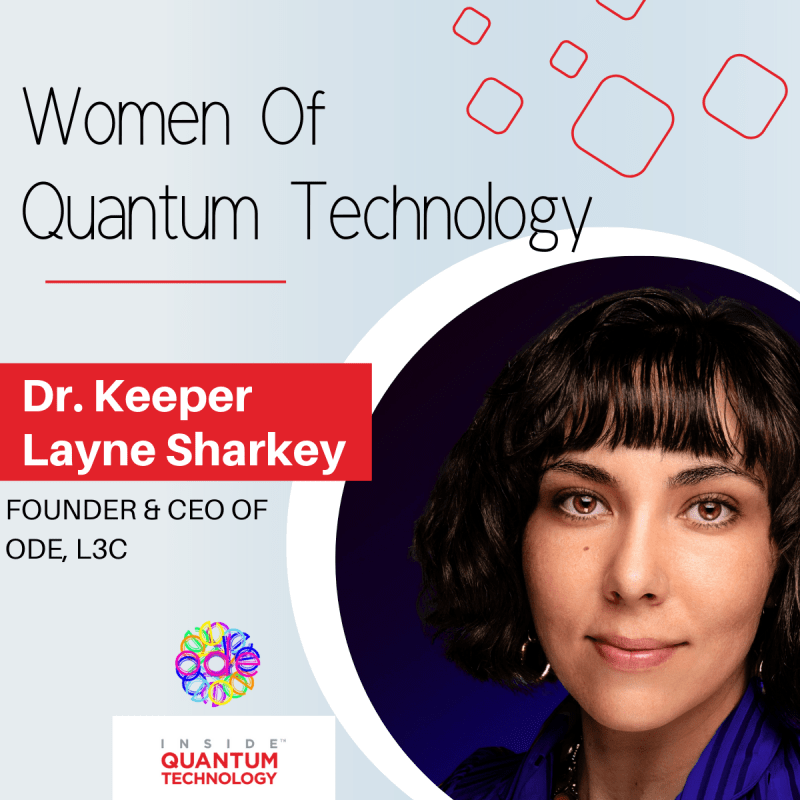Women of Quantum Technology: Dr. Keeper Layne Sharkey of ODE, L3C

As a female founder and CEO of the successful quantum chemistry company ODE, L3C, Dr. Keeper Layne Sharkey understands that she plays an essential role in helping to usher other women into the quantum computing ecosystem. “I have worked with mostly men in my career,” she stated. “Very few women and the women I do work with are powerful people.”
Sharkey’s passion for quantum computing dates to her childhood years and has strong ties to the historical tests of the atomic bomb in Nevada. “My interest in quantum technology started at a very young age,” explained Sharkey. “I was born and raised in Las Vegas, and there is the Nevada Test Site for the atomic bomb there. My grandfather was the forward area security guard. While I was growing up, I would hear many stories from his time there. He passed away before I was born from cancer due to radiation exposure. But my mother said he would come home at night, and his badge would glow due to the radiation. She said that they would sit on their roof at night in downtown Las Vegas and watch the bombs in the distance go off. Then, as a child growing up in elementary school, we would have bomb drills where we would have to hide under our desks in the event that an atomic bomb would go off. I don’t know if they still do that in Las Vegas, but that was big in the 1990s.”
Growing up in the rugged Nevada landscape, Sharkey found that it was the land that gave her the most memorable lessons about science. “As I got a little older, I sort of discovered magnetism on my own,” elaborated Sharkey. “There are ferrous composite sedimentary rocks in the area. I discovered that if you took two rocks, with one in each hand, and rotated them around one another, they would induce a magnetic polarity of each rock and repel one another. Then this is because these rocks have disordered nuclear spin states, and this rotation allows the spins to orient one another. Then the magnetic spin state becomes more measurable and noticeable. So, I was going around doing magic tricks, you know, for each camp, turning rocks into magnets.” As quickly as she had learned how to turn the rocks into magnets, Sharkey showed others how to turn them “off.” As she described: “Of course, you could disrupt the magnetic field that was created due to spinning the rocks by simply tapping them on each other, and it would re-disorder. The rocks were no longer magnetic.”
After her exploration of magnetism, Sharkey was quickly drawn into chemistry, having read a book on quantum chemistry by Linus Pauling in high school. “I got a job when I was about 18 working in the chemical stock room with a local community college, and that gave me many hands-on experiences mixing chemicals and learning about chemical properties,” She added. “And I realized that not only was the chemistry exciting for me, but the mathematics was very important.” This realization made Sharkey pursue a double major in mathematics and chemistry at the University of Arizona, using her interests to examine quantum mechanics. “I published six papers on highly accurate quantum mechanical, finite nuclear mass variational calculations, using explicitly correlated Gaussian functions,” Sharkey stated. “I know that’s a mouthful.”
Sharkey was already transitioning into the quantum industry and would later create ODE, L3C, thanks to her college career. “I can say that I entered the quantum industry, really, before the quantum industry was really declared as an industry,” she elaborated. “This is really the second generation of quantum. So, the first generation of quantum started in the 1920s. And it really lasted until about the early 2000s, when we decided that we were going to use quantum for computing. But it took a long time to get to a place where we could call it an industry. So, now we have this quantum industry. We started understanding the use cases for quantum.” In Sharkey’s case, she focused on use cases around chemistry.
Transitioning from academia into the quantum industry itself and creating ODE, L3C, Sharkey found, was straightforward. She explained, “After I graduated with my Ph.D. [in 2015] and having published another 20 papers in a graduate school funded by National Science Foundation, I decided to start my own business, mainly due to the national quantum initiative, in 2018. I decided that was the best way to carry my science forward.” Now as the CEO and Founder of ODE, L3C, Sharkey is excited by the benefits that her company can provide to others. “ODE, L3C is a public benefit research institution with a for-profit product called QLEAN, which stands for quantum logical electrons and nuclei,” she added. “We work on solving highly accurate chemical simulations. QLEAN is actually a quantum virtualization tool.” Through her work on QLEAN, Sharkey realized that quantum visualizations could also impact cybersecurity. “I got really excited about that and wrote a white paper on quantum chemistry as a cybersecurity solution,” she elaborated. “Which led me to be named a 40 under 40 in cybersecurity for 2023 by Top Cyber NEWS Magazine from Capitol Tech University. I’m working on using these advanced quantum mechanics and quantum mechanical calculations as a cybersecurity solution for post-quantum cryptography.” Thanks to her unique approach, Sharkey has quickly become one of the leading experts in quantum cybersecurity within the quantum computing ecosystem. Besides leading ODE, L3C, she is also the Chair of Cyber Security in Quantum Computing & Quantum’s Effect on Current Architectures in the Cyber Security for Next Generation Connectivity Systems of IEEE. She is also the Co-Chair for the Digital Exhaust Threats and Mitigation Cross-Sector Council at InfraGard, among other roles in the chemical industry. She also spoke on post-quantum cryptography at the Credit Union National Association cyber security conference this June.
Being a leader within this niche area and a female CEO, Sharkey also suggests ways to bring in other female leaders within the industry, making it more inclusive. “As quantum technologies become more expansive, and the workforce development initiatives grow over time, the diversity in the industry will improve,” Sharkey explained. “As we have more undergraduate education [developed], I think diversity will grow in quantum information sciences. We need to keep moving that forward.” Part of her effort to enhance undergraduate education has been led by Sharkey authoring the book titled Quantum Chemistry and Computing for the Curious: Illustrated with Python and Qiskit code, and she headed to California State University this June to teach non-QIST faculty to assist in course development and curriculum design.
Kenna Hughes-Castleberry is a staff writer at Inside Quantum Technology and the Science Communicator at JILA (a partnership between the University of Colorado Boulder and NIST). Her writing beats include deep tech, quantum computing, and AI. Her work has been featured in Scientific American, Discover Magazine, Ars Technica, and more.





















